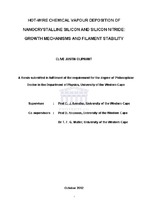| dc.description.abstract | Nanocrystalline silicon (nc-Si:H) is an interesting type of silicon with superior
electrical properties that are more stable compared to amorphous silicon (a-Si:H).
Silicon nitride (SiNₓ) thin films are currently the dielectric widely applied in the
microelectronics industry and are also effective antireflective and passivating layers
for multicrystalline silicon solar cells. Research into the synthesis and
characterization of nc-Si:H and SiNₓ thin films is vital from a renewable energy
aspect. In this thesis we investigated the film growth mechanisms and the filament
stability during the hot-wire chemical vapour deposition (HWCVD) of nc-Si:H and
SiNₓ thin films. During the HWCVD of nc-Si:H, electron backscatter diffraction (EBSD) revealed that the tantalum (Ta) filament aged to consists of a recrystallized Ta-core with Ta-rich silicides at the hotter centre regions and Si-rich Ta-silicides at the cooler ends nearer to the electrical contacts. The growth of nc-Si:H by HWCVD is controlled by surface reactions before and beyond the transition from a-Si:H to nc-Si:H. During the transition, the diffusion of hydrogen (H) within the film is proposed to be the reaction controlling step. The deposition pressure influenced the structural, mechanical and optical properties of nc-Si:H films mostly when the film thickness is below 250 nm. The film stress, optical band gap, refractive index and crystalline volume fraction approached similar values at longer deposition times irrespective of the deposition pressure. Filament degradation occurred during the HWCVD of SiNₓ thin films from low total flow rate SiH₄ / ammonia (NH₃) / H₂ gas mixture. Similar to the HWCVD of nc-Si:H, the Ta-core recrystallized and silicides formed around the perimeter. However, Tanitrides formed within the filament bulk. The extent of nitride and silicide formation, porosity and cracks were all enhanced at the hotter centre regions, where filament failure eventually occurred. We also applied HWCVD to deposit transparent, low reflective and hydrogen containing SiNₓ thin films at total gas flow rates less than 31 sccm with NH₃ flow rates as low as 3 sccm. Fluctuations within the SiNₓ thin film growth rates were attributed to the depletion of growth species (Si, N, and H) from the ambient and their incorporation within the filament during its degradation. | en_US |

